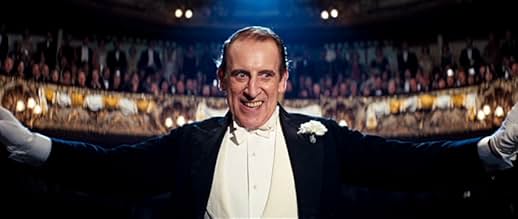The Boy Friend (1971) ⭐ 6.8 | Comedy, Musical, Romance (original) (raw)
2h 17m

When the leading lady of a low-budget musical revue sprains her ankle, the assistant stage manager is forced to understudy and perform in her place, becoming a star and finding love in the p... Read allWhen the leading lady of a low-budget musical revue sprains her ankle, the assistant stage manager is forced to understudy and perform in her place, becoming a star and finding love in the process.When the leading lady of a low-budget musical revue sprains her ankle, the assistant stage manager is forced to understudy and perform in her place, becoming a star and finding love in the process.
More like this
Despite whatever intoxicated tangents Ken Russell has embarked on in some of his other works, 'The Boy Friend' is a particularly enchanting anomaly for this director. Working loosely from Sandy Wilson's Broadway musical 'The Boyfriend,' Russell's screenplay relegates Wilson's original work to a mere production-within-a-production -- 'Noises Off'-style, as it were. Set in1920's London, the owner of a decaying theater company in the East End realizes that a big-shot Hollywood director, Cecil B. DeThrill, has dropped in to watch a performance, and he instantly regrets thrusting the young Assistant Stage Manager, Polly (played by Twiggy), onto the stage to fill the shoes of the show's star (Glenda Jackson, in an uncredited cameo), who's laid up in the hospital after getting her foot stuck in a tramline while en route to the performance. As with 'Noises Off,' the movie is a farce dealing with a potentially disastrous stage performance, although the backstage drama is more interwoven with the onstage production itself, so that the play dominates the duration of the film while serving as a window onto the backstage chaos.
The members of the theatre company are vain and starved to impress DeThrill, bitterly upstaging one another and overreaching for the Hollywood bigwig's attention. Amidst them, of course, is Twiggy's Polly, humble, nervous and in love with leading man Tony, who may or may not be carrying on an affair with one of the company's coquettish young actresses. Her feelings, at any given moment -- ranging from adoration to heartbreak, based upon what she half-observes -- dictate the course of her onstage performance and her ad-libs.
Wilson's play deals trivially with class divide, and it's interesting to note how the company's performers, all unrefined East Enders, play on their slanted notion of the upper-class. The actresses Russell has cast have a particular big-eyed, blinking appeal, the wider their shark-like onstage smiles, the greater the underhandedness being masked. The farcical elements are well-played, and Russell's signature brand of calculated bawdiness is appropriate for this context.
The brightest element of the movie, however, is Twiggy. Here, she is endearing and delicate, charmingly unsophisticated in an Eliza Doolittle fashion. Her performance in 'The Boy Friend' is unusually pure and sympathetic for something found in a Ken Russell film, and in a way, her character's predicament can be seen as a metaphor for Twiggy's appearance in this film. She is commanding through her gentle submissiveness, standing radiantly apart from the gloss of what surrounds her. Russell's strategy in establishing Twiggy's Polly as a most sympathetic protagonist seems to be directing her to perform, onstage, in the most naturalistic way possible, while every other member of the company performs in alternately forced, unnatural, and ham-fisted manners (pandering to DeThrill, of course, but at times reaching bizarre extremes of unnaturalness).
Unfortunately, for much of the film, Twiggy is completely swallowed by Ken Russell's extravaganza, in which he either pays homage to or simply satirizes Busby Berkeley with quite glorious (but characteristically excessive) widescreen tableaux. He has his entire library of tricks on hand, expressed in 'fantasy' sequences, in which an American flag backdrop dominates the entire frame in one instance, and a black & white movie projected onto a screen, positioned squarely in the center of the frame, itself turns into a Berkeley-style number. Another fantasy sequence, shot in a rustic outdoor environment, is ugly and dated, and does not fit with the rest of the film. It should have been excised.
Like most of Russell's films, 'The Boy Friend' looks and sounds great. The movie is often a joy to watch, particularly in its first hour. As much as I admired its visuals and the tight rhythms of its wit, I found myself longing, after it ended, for more of Twiggy's warmth and less of Russell's technical virtuosity. Still, a most enjoyable movie.
- MichaelCarmichaelsCar
- Jan 6, 2005
- Permalink
Suggest an edit or add missing content

What is the Spanish language plot outline for The Boy Friend (1971)?

